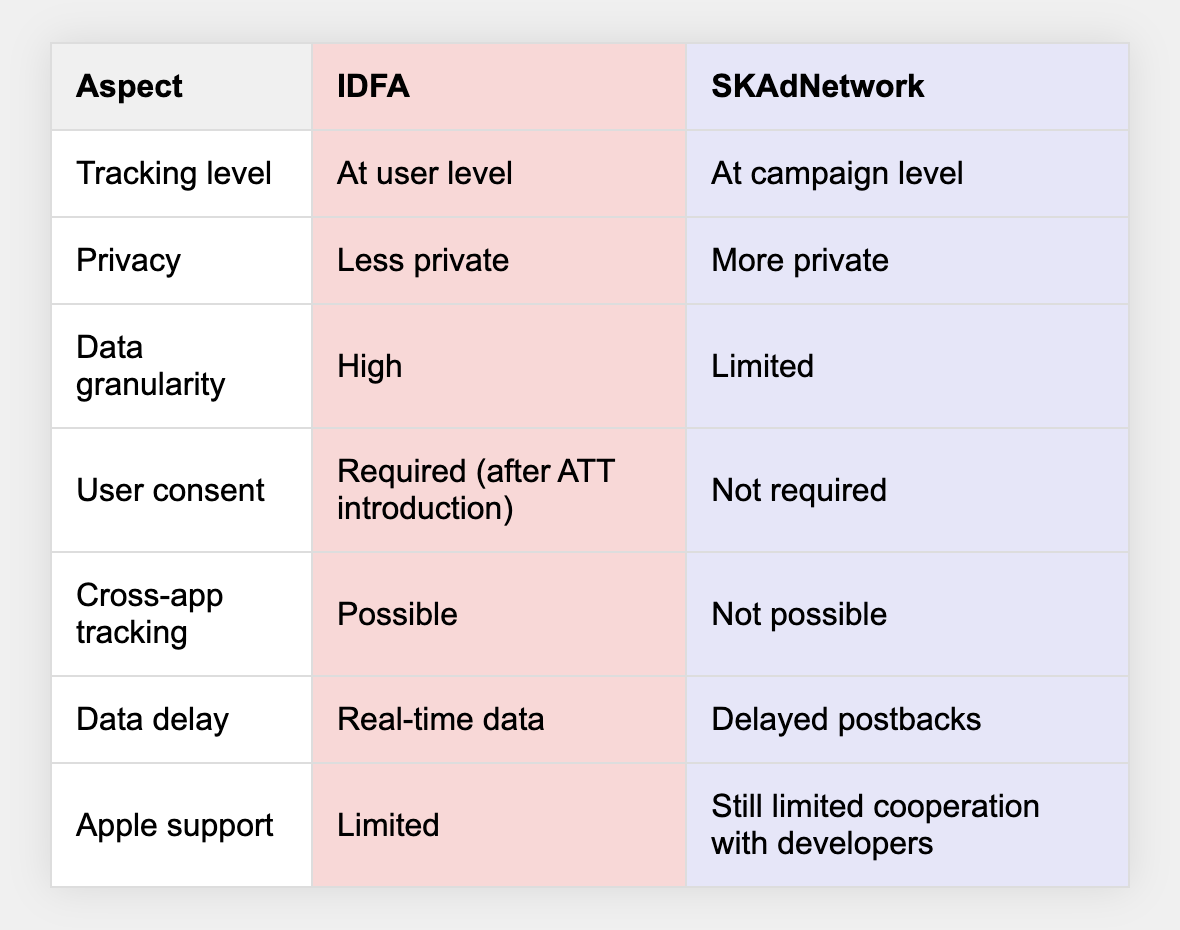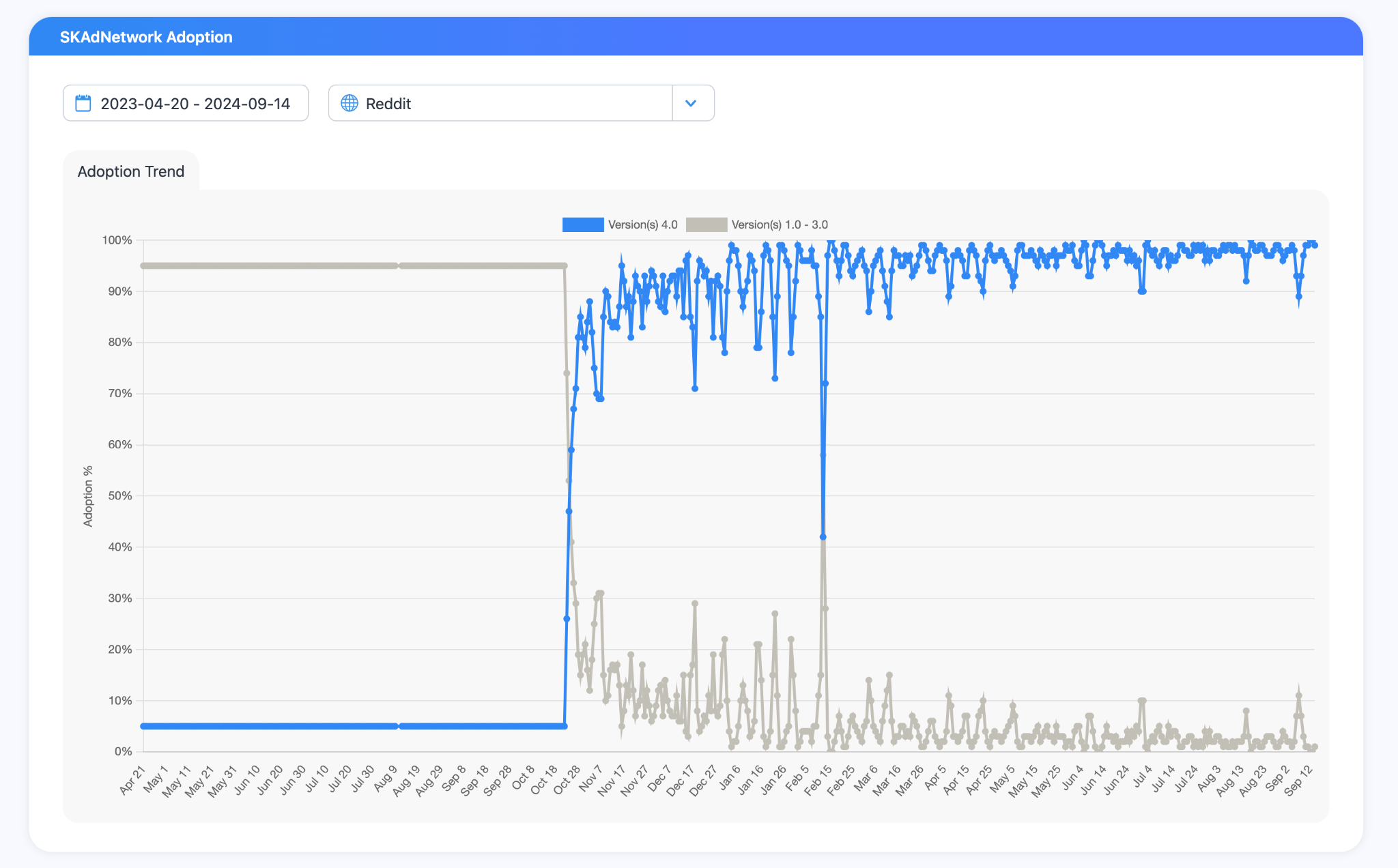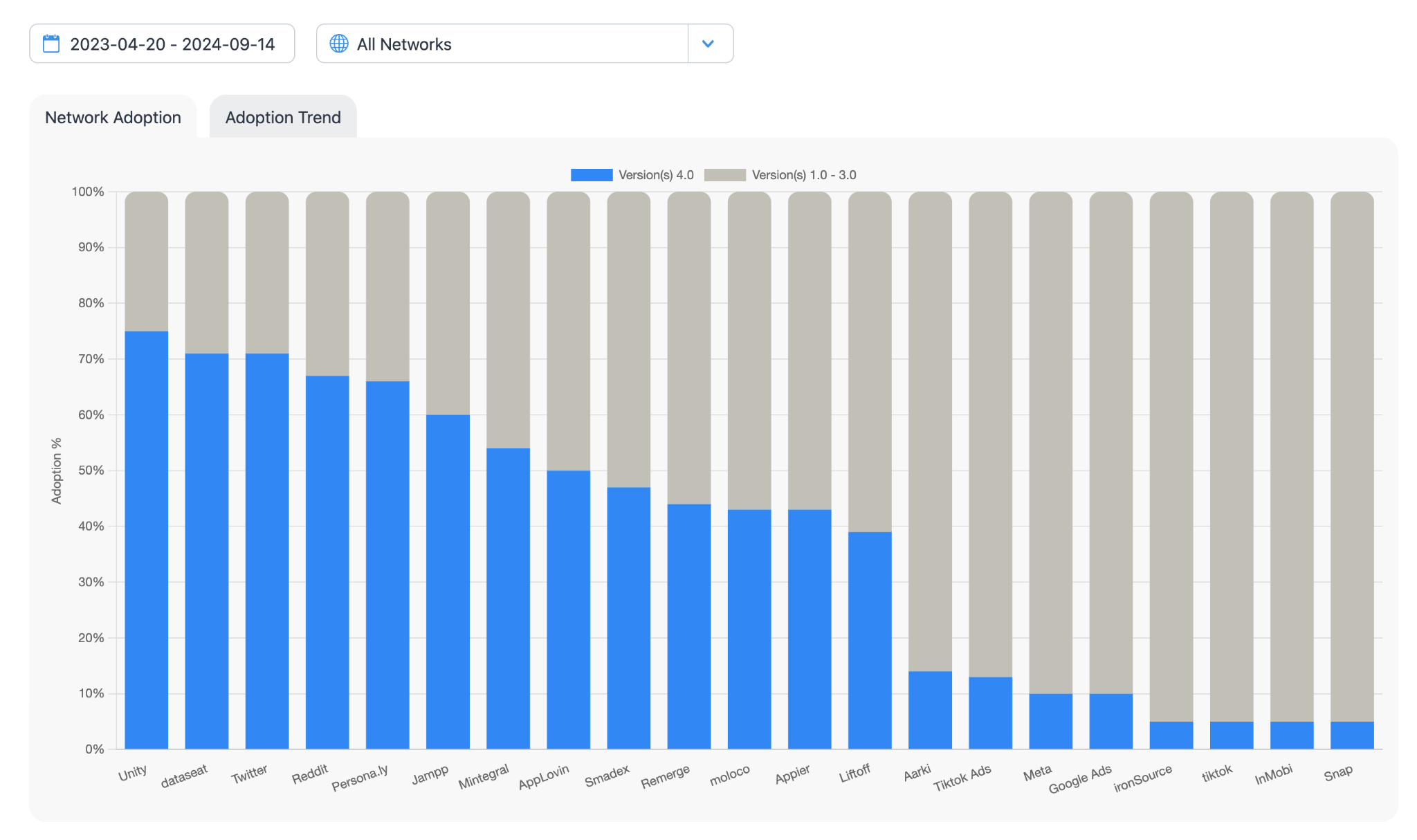SKAdNetwork: How Apple deals the cards in the Poker Game of iOS User Acquisition?
What is SKAdNetwork (SKAN) and how has it revolutionized mobile attribution and user acquisition on iOS? What challenges do marketers face when transitioning from IDFA to SKAN? What are the key differences between SKAN 3.0 and SKAN 4.0? Why has revenue measurement become so complicated in the SKAN era, and how do Mobile Measurement Platforms (MMPs) like AppsFlyer address this challenge? How does Apple Search Ads stand out compared to other user acquisition platforms in the context of SKAN? What is the Crowd Anonymity mechanism in SKAN 4.0, and how does it affect the availability of data for marketers? All of this will be covered in the text below.
1. SKAdNetwork: A New Chessboard in the Game for iOS Users
In recent years, we have witnessed a true revolution in the world of mobile app and game marketing, particularly on the iOS platform. This transformation, although initiated by the introduction of SKAdNetwork (SKAN) by Apple in 2018, gained real momentum with the release of iOS 14.5 in April 2021. It was then that Apple introduced the requirement for App Tracking Transparency (ATT), fundamentally changing the rules of the game for marketers, advertisers, and app developers.
Initially a limited tool, SKAdNetwork became a crucial element of the iOS advertising ecosystem after the implementation of ATT. The requirement for explicit user consent to access the Identifier for Advertisers (IDFA) made SKAN the primary method of app install attribution for many advertisers.
At the core of these changes lies a growing concern for user privacy, which has become not only an ethical imperative but also a key part of Apple’s business strategy. The shift from an era of free access to user data to an environment where privacy is prioritized has required the entire industry to undergo deep transformation and adaptation.
The scale and impact of these changes are impressive. According to the latest data from AppsFlyer, ATT opt-in rates for users who saw the prompt are currently 51% for gaming apps, 66% for financial apps, and 49% for e-commerce apps. These numbers show that despite initial concerns, a significant portion of users are willing to share their data in exchange for a better app experience. At the same time, nearly half of users choose to protect their privacy, posing a significant challenge for marketers.
Moreover, despite the initial difficulties in adapting to the new system, the industry quickly adjusted, and advertisers are increasingly focusing on iOS due to its valuable audience. Data from AppsFlyer shows an impressive trend: around 50% of apps increased their advertising spend on iOS from Q1 2023 to Q1 2024, with a year-over-year growth of 28%.

Source: Appsflyer.com
This is a clear signal that despite the challenges, iOS remains a critically important platform for mobile app and game marketing. This trend is particularly noticeable in the North American market, where iOS holds a dominant share of 54.21%. Coupled with the higher spending habits of iPhone users, it makes optimizing campaigns on iOS a key priority for marketers, even in markets where Android holds a larger share.
Three key elements are at the forefront of this transformation: App Tracking Transparency (ATT), SKAdNetwork (SKAN), and Apple Search Ads. Each plays a unique role in shaping the new landscape of mobile marketing on iOS.
App Tracking Transparency (ATT) is a mechanism that gives users direct control over whether apps can track their activity across different apps and websites. This simple but powerful tool has changed the dynamics of the relationship between users and apps, putting privacy front and center.
SKAdNetwork (SKAN) is Apple’s response to the need for measuring the effectiveness of ad campaigns in a world where individual user tracking is becoming increasingly difficult. This framework offers a way to attribute app installs without compromising user privacy, introducing a whole new approach to data analysis and campaign optimization.
Apple Search Ads, although not a new element, has gained importance in the context of these changes. As an advertising platform integrated into the Apple ecosystem, it offers unique targeting and measurement capabilities for ads in the App Store, becoming a key tool for many app marketers.
In this comprehensive article, we will dive into each of these aspects. We will analyze how App Tracking Transparency has changed the dynamics of user consent and how marketers can optimize their strategies in this new context. We will take a closer look at SKAdNetwork, its functionality, limitations, and best practices for utilizing it. We will also explore how Apple Search Ads is evolving in this new landscape, what unique opportunities it offers to advertisers, and what advantages it holds over other channels for acquiring users for mobile games and apps.
Additionally, we will examine the challenges these changes present to mobile user acquisition specialists. From the need to reformulate targeting strategies, to adapting new methods of data analysis, to the necessity of educating teams and clients—these changes affect virtually every aspect of mobile marketing.
Our guide is designed to help you navigate these complexities and improve your iOS strategies. You will find practical tips and expert insights that will help you succeed in SKAdNetwork and unlock the full potential of your mobile campaigns on iOS. Whether you are an experienced mobile user acquisition specialist for apps and games, an advertiser looking for new opportunities, or a developer trying to understand the implications of these changes for your product, this article will provide you with a deep understanding of the new iOS app marketing landscape.
We invite you to explore the fascinating world of SKAdNetwork and the innovations that accompany it—a world that is transforming the face of mobile marketing before our eyes.
2. App Tracking Transparency (ATT)
A new era of privacy has dawned in the world of mobile app and game marketing, and its symbol is App Tracking Transparency (ATT), introduced by Apple. Although ATT was announced with iOS 14 in 2020, its mandatory implementation only came into effect with the iOS 14.5 update on April 26, 2021. This solution, which at first glance may seem like a challenge for marketers, in reality opens the door to building deeper, trust-based relationships with users.
ATT is a mechanism that gives users full control over whether apps can track their activity across other apps and websites. When a user launches an app for the first time after updating to iOS 14.5 or later, they see a simple question: allow tracking or not? This seemingly simple interaction has huge implications for the entire mobile marketing ecosystem.
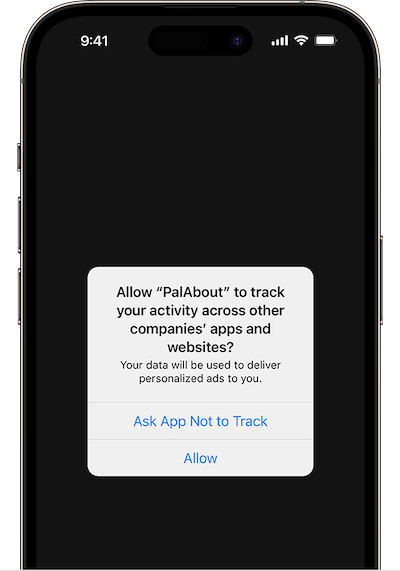
Source: Apple.com
For advertisers, the decision to implement ATT is not straightforward. On one hand, obtaining user consent opens access to valuable data, enabling precise attribution and campaign optimization.
On the other hand, some advertisers may choose not to implement ATT. They can still rely on SKAdNetwork (SKAN) for aggregated attribution, avoiding the potential negative impact on user engagement. This approach may be particularly attractive to companies that do not heavily rely on targeted ad campaigns or do not run advertising campaigns for mobile games and apps at all.
It’s important to note that SKAN, introduced back in 2018, gained prominence precisely in the context of ATT. It has become a key tool for marketers, enabling conversion tracking without violating user privacy.
The key to success in the ATT era is skillfully choosing the timing and method of presenting the consent request. This strategy can vary significantly depending on the type of app and its users. Let’s take a closer look at some approaches that work in different scenarios.
According to AppsFlyer, for ad-based mobile games, the most effective strategy is often to display the consent request right before showing the first ad. This approach makes sense—the user is already engaged with the game and better understands why the app is asking for permission to track. This can be paired with a brief explanation of how the user’s consent helps keep the game free and improve the quality of the ads.
On the other hand, mobile apps operating in a subscription model (SAAS) may achieve better results by requesting consent right after user registration. At this point, the user is already invested in the app and more likely to grant permission, especially if it is explained how this will help personalize their experience.
An interesting strategy gaining popularity is the delayed display of the consent request. Some advertisers achieve higher opt-in rates by waiting a few days after installation before presenting the ATT prompt. This method gives users time to familiarize themselves with the app and appreciate its value, which may increase their willingness to give consent.
Maximizing opt-in rates is an art worth mastering. Data shows that most apps achieve the best results when the consent request appears during the first launch. However, this is not a rule without exceptions. Some advertisers succeed by delaying the request for a few days, allowing users to see the app’s value first.
User education is also key. A brief explanation of why consent is important and how it can improve the app experience can significantly impact the user’s decision. Strong brands certainly have an easier time here!
It’s also worth considering the context in which the request is presented. For example, a subscription-based mobile app for language learning could ask for consent right after the user completes their first lesson, explaining that this will allow for better customization of their learning experience.
Regardless of the chosen strategy, continuous testing and optimization are essential. What works for one app may not work for another. It’s worth experimenting with different timings, wording, and screen designs, always measuring their impact on opt-in rates.
Let’s not forget that the mandatory introduction of ATT with iOS 14.5 was a turning point for the industry. It gave users unprecedented control over their data while forcing marketers to radically rethink their strategies. Although initially seen as a challenge, ATT has become a catalyst for innovation in mobile marketing, leading to the development of new, more ethical, and privacy-focused approaches to advertising and data analysis.
Remember the days when tracking the effectiveness of ad campaigns was like reading an open book? Well, those days are over, and SKAdNetwork has taken the stage (currently, most postbacks are sent via SKAN 3.0 and SKAN 4.0). But don’t panic! While it may seem like Apple has taken away our favorite toy, they’ve actually given us a new one—much more complex (veerrry complex). Let’s take a look at what has changed and how it impacts our daily marketing lives.
3. IDFA vs SKAdNetwork: Two Approaches to Mobile Attribution
What is IDFA?
IDFA (Identifier for Advertisers) is a unique, random identifier assigned by Apple to each iOS device. Before the introduction of App Tracking Transparency (ATT), IDFA was widely used as a tool for tracking user activity for advertising and analytics purposes.
Key features of IDFA:
- Unique to each device
- Resettable by the user
- Allows precise tracking of user behavior across apps and websites
- You can access a user’s IDFA, for instance, on an MMP platform.
IDFA vs SKAdNetwork: Key Differences
The End of the Digital Detective Era
Remember the days when we could track every user like a detective with a magnifying glass? IDFA was our best friend. We knew that John Doe installed our app after seeing an ad on Instagram and then bought three pairs of socks in it. Now, with SKAdNetwork, it’s more like playing a game of blind man’s bluff. We don’t know exactly who did what, but we know someone did something within a certain time frame.
Less Detail, More Privacy
In the past, our reports looked like an encyclopedia—full of details about every user, their behavior, and preferences. SKAdNetwork says, “Whoa, slow down cowboy!” Now, we receive data in aggregated form, in convenient little packages called “buckets.” It’s like getting information that “Group A spent between $5 and $10,” instead of exact amounts for each user. Fewer details, but still enough to make smart decisions.
New Activity Windows
In classic attribution, we could track users over a long period of time. SKAdNetwork (SKAN4) introduces specific conversion windows: 0-2 days, 3-7 days, and 8-35 days. It’s like having three friends who report to us on what’s happening at different moments. The first one is quick but has a short memory. The second has a broader perspective, and the third—well, they like to take their time before saying anything.
Patience is a Virtue
With SKAdNetwork, you need to learn patience. Data arrives with a delay—from 24 hours up to even 64 days in extreme cases. It’s like waiting for a letter you know will come, but you’re not sure exactly when.
Adapting Marketing Strategies
A key element of this transformation is adapting our marketing strategies. Instead of focusing on precise targeting of individual users, we now need to concentrate our efforts on optimizing entire campaigns. This means that our priority is understanding broader trends and user behavior patterns, rather than tracking individual conversion paths.
Modeling—The New Superpower
With SKAdNetwork, data modeling becomes our new superpower. It’s like being a detective who must reconstruct an entire story from a few clues. Harder? Definitely.
Privacy—The New King
SKAdNetwork puts privacy first. It’s like moving from “we know everything about everyone” to “we know enough to be effective without infringing on anyone’s privacy.” This presents an opportunity to build more ethical and sustainable marketing strategies.
Challenges and Opportunities
There’s no denying it—SKAdNetwork (SKAN) is more complex. It’s like switching from driving automatic to manual—at first, it can be tough. Everything depends on the effort you put in. This shift requires us to develop new skills and analytical tools. We must learn to apply advanced data modeling techniques that allow us to estimate metrics we previously could measure directly.
4. What is SKAdNetwork and How Does It Work?
In a world where user privacy is becoming increasingly important, Apple introduced a groundbreaking solution for the mobile marketing industry—SKAdNetwork (SKAN). This innovative system changes how advertisers measure the effectiveness of their campaigns on the iOS platform, with user privacy as the top priority.
What is SKAdNetwork?
SKAdNetwork is a framework created by Apple that enables tracking the effectiveness of advertising campaigns without compromising the privacy of individual users. Instead of providing detailed data on each user, SKAN offers aggregated information on campaign performance, maintaining the anonymity of iOS device users.
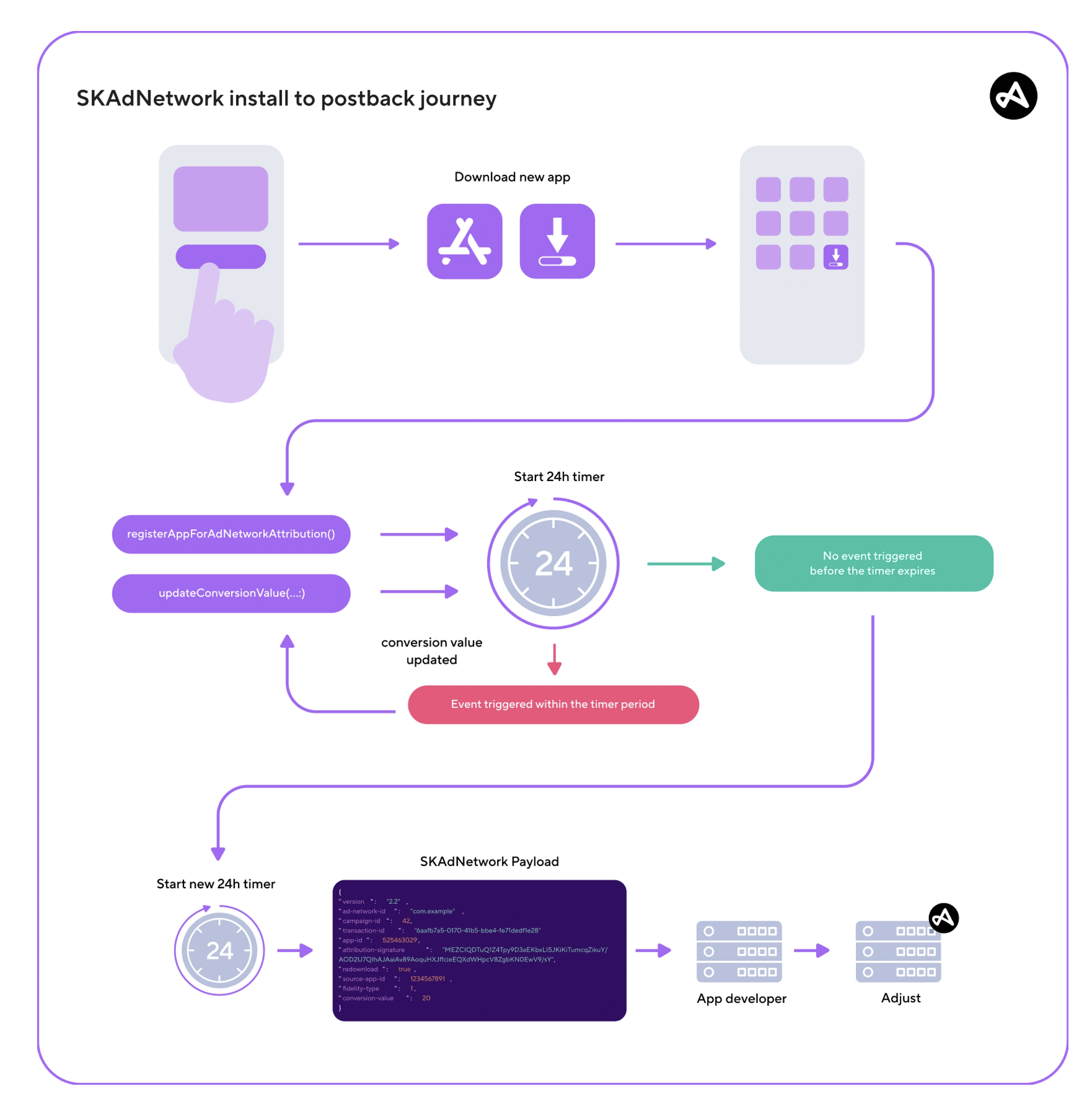
Source: Adjust.com
Key Players in the SKAdNetwork Ecosystem
Several key entities participate in the SKAdNetwork process:
- Apps displaying ads (Publishers): These are the apps where users see ads for other apps.
- Ad platforms (Ad networks): They act as intermediaries between advertisers and apps displaying ads.
- Advertised apps (Advertiser): These are the products whose installation advertisers aim to promote.
- Attribution tools (MMPs: AppsFlyer, Adjust, Singular, Airbridge, Branch, Tenjin, Kochava): They help interpret the data provided by SKAdNetwork.
How Does SKAdNetwork Work?
SKAdNetwork operates in a way that ensures user privacy while still providing valuable information to advertisers. Here are the key stages of this process:
- Ad Display: An ad is shown with an SKAN label, which contains the campaign identifier. When a user views the ad for at least 3 seconds, the publisher notifies SKAdNetwork of a successful ad display.
- Interaction with the Ad: If the user clicks on the ad, they are redirected to the app’s page in the App Store via StoreKit. SKAdNetwork registers the proper display of the app page.
- App Download: After downloading and installing the app from the App Store, Apple identifies the campaign from which the installation originated, using the SKAN label.
- Registration with SKAN: When the app is launched for the first time, the method registerAppForAdNetworkAttribution is called, which starts a 24-hour timer for the installation.
- Conversion Events: If conversion events occur during this period, the app calls the updateConversionValue method, which updates the conversion value and resets the timer for another 24 hours (SKAN3).
- End of Timer: If no updates occur within 24 hours, the timer ends. To mask the exact installation time, SKAdNetwork delays sending the postback by up to 24 hours.
- Postback After Installation: After 24 hours, SKAdNetwork sends a postback to the ad network, confirming the installation. The postback includes information about the installation and the conversion value.
Challenges in SKAdNetwork
SKAdNetwork (SKAN) is an innovative solution from Apple that is revolutionizing the way we measure the effectiveness of advertising campaigns on iOS. Here’s what makes SKAN unique:
Privacy First: SKAN ensures user anonymity, not sharing any data that could identify users. This is a fundamental shift in mobile marketing.
Delayed Reporting: Campaign data (postbacks) is delivered with a delay. While this may seem inconvenient, it actually serves as an additional layer of user privacy protection.
Limited Data Granularity: Instead of receiving information about individual users, advertisers get aggregated data. This forces marketers to adopt new approaches to campaign analysis. They must learn how to optimize campaigns with less detailed data. It is necessary to develop new key performance indicators that work within the constraints of SKAN. A creative approach to using available data is essential to continue achieving marketing goals.
Although SKAdNetwork (SKAN) presents new challenges for marketers, it also opens the door to a more ethical and innovative approach to paid user acquisition on iOS. It offers the opportunity to build deeper, trust-based relationships with users while still achieving business goals. However, it also increases the likelihood of overspending on app or game marketing budgets.
The SKAN model, which prioritizes user anonymity, introduces certain limitations regarding the monitoring of metrics such as user retention. Due to high privacy standards, SKAN does not collect individual device identifiers, which are crucial for tracking long-term user activity. Additionally, device sessions are not automatically recorded, and those that are must be precisely defined within a structured data schema and fall within specific measurement windows.
Feedback, or postbacks from SKAN4, is delivered for specific time windows (Day 0-2, Day 3-7, Day 8-35) and treated as separate events, making it impossible to combine data across different periods. This structure makes it significantly harder to analyze user retention, posing a challenge for analysts when assessing and improving the long-term value of users in apps and web services. As a result, while SKAN effectively safeguards user privacy, it also becomes a barrier to efficiently analyzing user behavior.
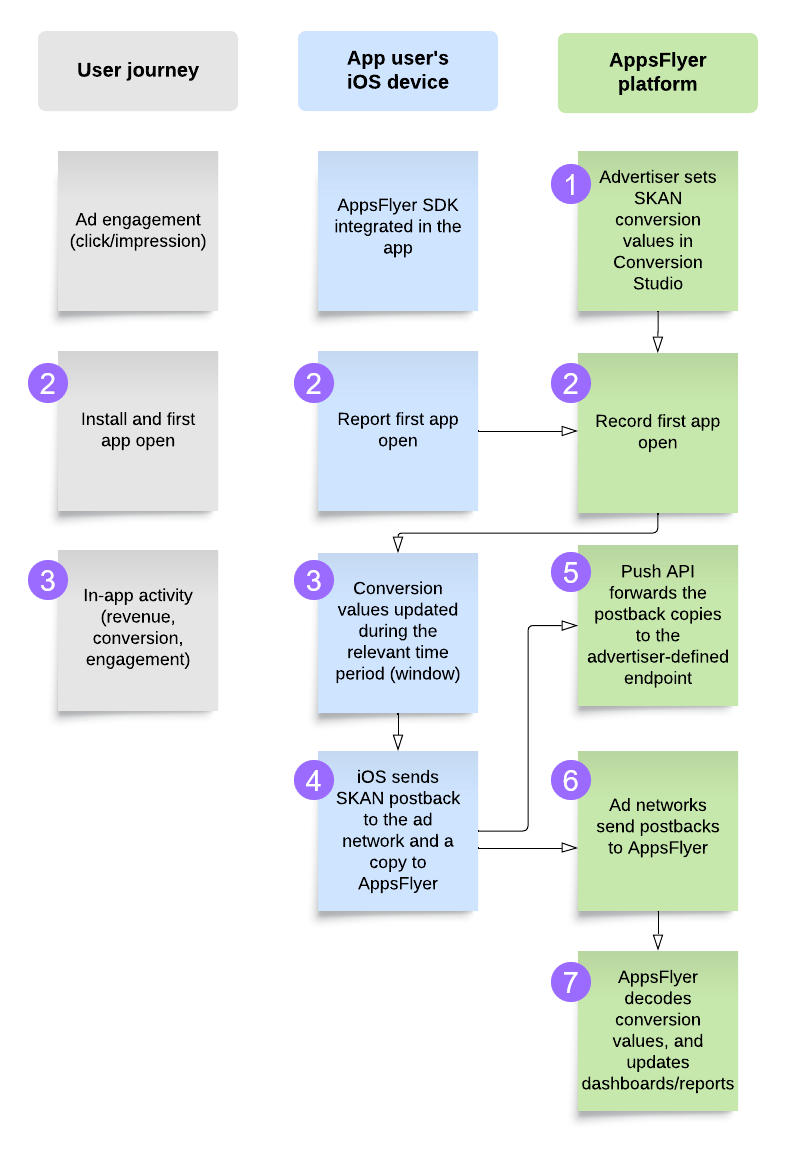
Source: Appsflyer.com
SKAN 3.0
SKAdNetwork 3.0 (SKAN 3.0) is an iOS framework developed by Apple for privately tracking ad campaigns, operating independently of user consent for tracking. Its main feature is sending a single postback for each app installation.
When a user installs an app after interacting with an ad, SKAN 3.0 determines the ad channel responsible for that installation. The activity window in SKAN 3.0 and earlier versions lasts from 12 hours to 63 days (the activity window can be extended to 63 days with conversion updates and timer resets). After this period, SKAN 3.0 sends one postback containing attribution data to the appropriate ad channel.
This single postback contains key information such as the campaign identifier, the app identifier, and the conversion value. The conversion value is a number ranging from 0 to 63, which encodes information about the user’s activity after installation.
The postback is not sent immediately after the 24-hour tracking period. Instead, it is sent at a random time within the next 0-24 hours, which further enhances user privacy.
It’s important to note that in SKAN 3.0, conversion values can only be updated to higher numeric values. This means that if the system has already recorded a higher conversion value, it will not be downgraded, even if the user later performs an action of lower priority.
By sending only one postback with limited information, SKAN 3.0 strikes a balance between the needs of advertisers and the privacy of iOS users. It provides basic data on the effectiveness of advertising campaigns while significantly limiting the amount of information shared about individual users.

Source: Airbridge.io
SKAN Compatibility with Different iOS Versions
When implementing the SKAN system for measuring advertising campaigns, there are a few important considerations to keep in mind. First and foremost, we may not always be able to use the latest version of this tool.
The availability of a specific SKAN version depends on two main factors:
- Support from the ad network (for example, it’s worth checking data from platforms like Singular)
- The iOS version on the user’s device
Here’s a quick summary of SKAN versions:
- The latest iOS (16.1+) uses SKAN 4.0
- Mid-range iOS versions (14.6 – 16.0) use SKAN 3.0
- Older systems (iOS 14.5 and earlier) operate on SKAN 2.2 or older
It’s important to keep this in mind when planning advertising campaigns and analyzing their results.
5. SKAN 4.0 – A Revolution in Mobile Attribution
SKAdNetwork 4.0 (SKAN 4.0) introduces fundamental changes to how mobile campaigns are measured and analyzed on the iOS platform. One of the key innovations is the introduction of a multi-postback system (three postbacks) compared to the single postback in SKAN 3.0, which significantly enhances the ability to track user behavior over time.
New Postback System and Conversion Windows
SKAN 4.0 offers 3 postbacks, each with its own conversion window:

SKAN 4.0 Postbacks
This structure allows marketers to track user behavior over a much longer period than before, which is especially important for apps with a longer conversion cycle.
Fine Conversion Value and Coarse Conversion Value
SKAN 4.0 introduces a distinction between fine-grained and coarse-grained conversions, which represents a significant step towards more precise yet privacy-preserving conversion measurement.
Conversions in SKAdNetwork are divided into fine and coarse values, allowing for balanced tracking of user activity while maintaining user privacy.
Fine-grained conversions are used in the first postback. They offer a wide range of values from 0 to 63, enabling precise tracking of early user interactions with the app. These are ideal for measuring short-term, key events such as registration, completing a tutorial, making the first purchase, or reaching a certain level in a game within the first activity window after installation (0-2 days). This allows advertisers to quickly assess initial user engagement.
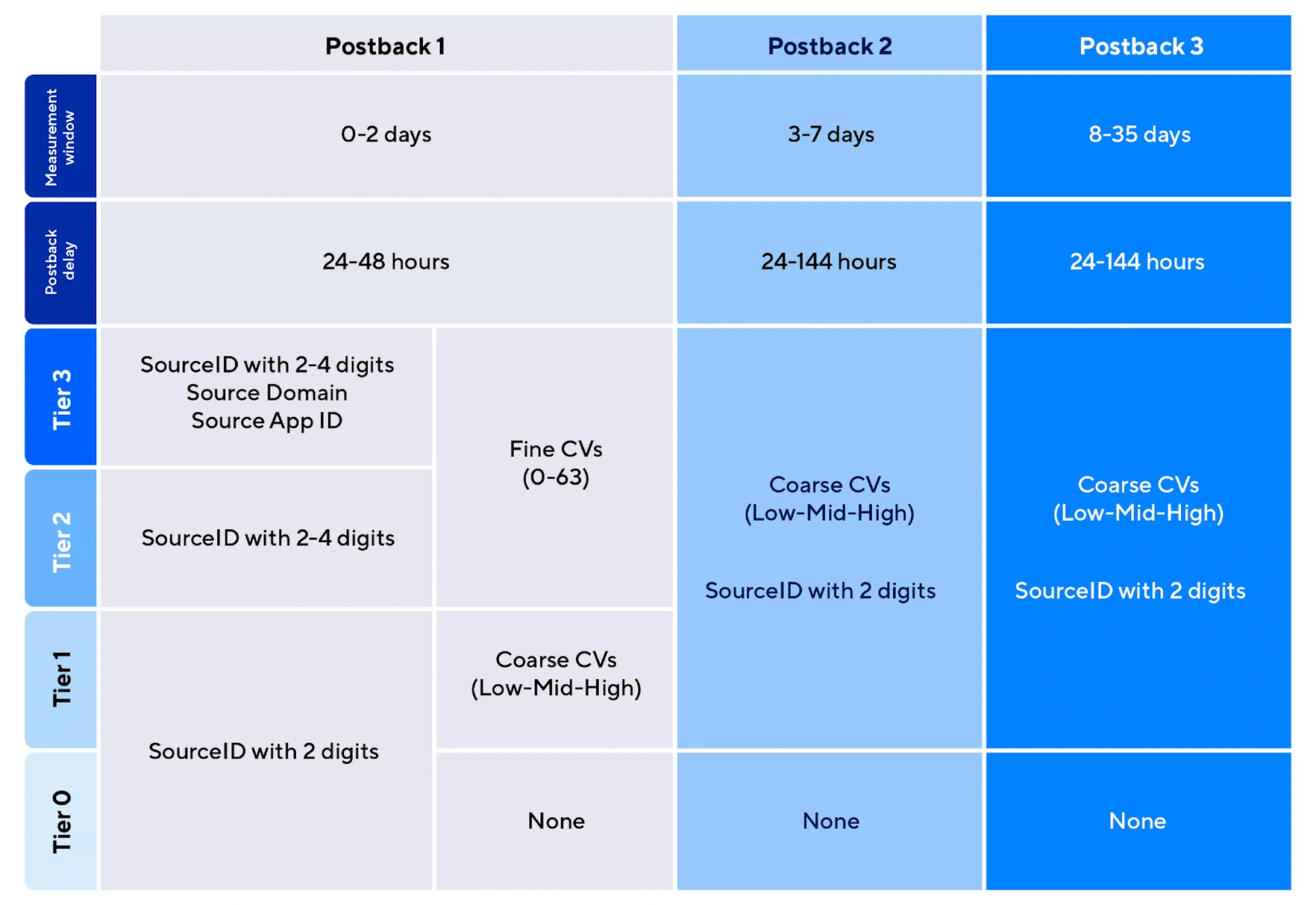
Source: Adjust.com
Coarse-grained conversions, on the other hand, are applied in the second and third postbacks. They offer three value levels: low, medium, and high, providing a general picture of user engagement over a longer period while still protecting privacy. It’s worth noting that coarse-grained conversions are also used in the first postback when the level of crowd anonymity is low, known as Tier 1.
This two-tiered conversion structure enables advertisers to gain detailed insights into early user actions while maintaining privacy protection over the long term. The combination of both conversion types provides valuable data on user trends and behaviors, balancing marketing needs with privacy.
Despite significant improvements, SKAN 4.0 still poses certain challenges for marketers. Postback reporting delays (the first postback up to 4 days after installation, the second up to 13 days after installation, and the third up to 41 days after installation) require adjusting campaign optimization strategies. The limited granularity in later postbacks forces a new approach to analyzing long-term trends. The complexity of implementing SKAN 4.0 necessitates close collaboration between marketing, development, and analytics teams.
To effectively leverage SKAN 4.0’s capabilities, marketers should focus on several key strategies. First and foremost, careful planning of conversion schemes (properly setting conversion values on platforms such as MMPs) that account for both short- and long-term campaign goals is essential. Developing advanced analytical models to interpret data from various postbacks becomes critical to fully understanding user behaviors.
In conclusion, SKAN 4.0 represents a significant leap forward in mobile attribution, offering marketers new possibilities while preserving user privacy. However, effectively harnessing its potential requires a deep understanding of the new mechanisms and a creative approach to data analysis.
For all three postbacks to be sent in SKAN 4.0, certain conditions must be met (e.g., the iOS version on the device must be 16.1 or later, the postback data tier must be Tier 1, Tier 2, or Tier 3, and the ad channel must support SKAN 4.0).
lockWindow
The lock window function, introduced in the latest version of Apple’s SKAdNetwork, is a breakthrough in how advertisers can control and optimize their ad campaigns on iOS. This innovative feature allows marketers to flexibly manage conversion measurement periods, which is particularly important in the dynamic world of mobile advertising.
In previous versions of SKAdNetwork, advertisers were limited by rigid time frames for conversion measurement. The new lock window function changes this, allowing the measurement window to be closed earlier. This enables advertisers to react more quickly to user behaviors and adjust their marketing strategies in near real-time.

Source: Apple.com
A practical use of the lock window might look like this: if a campaign achieves its primary goal (e.g., registering for a trial in a language learning app) earlier than expected, the advertiser can close the measurement window and immediately begin analyzing the data. This significantly speeds up the campaign optimization cycle, enabling faster, data-driven decisions.
However, using the lock window requires a well-thought-out strategy. Closing the measurement window too early may result in missing important later conversions. On the other hand, skillfully utilizing this function can greatly enhance the efficiency of ad campaigns, especially for short-term or seasonal promotions.
I Want SKAN 4.0 Postbacks, but I Receive SKAN 3.0 Postback
In the fast-moving world of mobile advertising, the full adoption of Apple’s SKAdNetwork 4.0 (SKAN 4) continues to be a challenge for the industry. Even market leaders, like Reddit, have reached only 95% (data from Singular) utilization of SKAN 4.0. The main obstacle appears to be older iOS devices that do not meet the latest system requirements.
SKAN 4.0 requires not only proper click coding by ad networks but also iOS version 16.1 or later on the user’s device. The issue is that as much as 19% of iOS devices still run on older systems, preventing full transition to SKAN 4.0.
Although achieving 100% adoption of SKAN 4 will take several more years, the industry is steadily moving toward this goal. This process will naturally progress as users replace older devices with newer ones. In the meantime, ad networks should actively prepare for full SKAN 4 implementation to be ready for future changes in the mobile advertising landscape.
Apple’s SKAdNetwork (SKAN), a tool designed to protect user privacy, recently revealed its complexity through a significant bug in SKAN 4. The issue, discovered in 2023, involved an unexpected resetting of conversion values (CV) to zero.
The bug was located in the AAAttribution.attributionToken function of Apple’s AdServices framework. Instead of merely retrieving the attribution token for Apple Search Ads, this function unexpectedly reset both SKAN 4 conversion values—the fine-grained and coarse-grained ones. As a result, the fine-grained conversion values were set to zero, and the coarse-grained values to “none.”
Singular (a mobile attribution platform) found that some apps, especially those with multiple SDKs, unintentionally triggered the problematic AdServices function at various times, creating a “race” where the last call reset all previous SKAN updates.
Singular reported the bug to Apple, stressing the urgent need for a fix. The company observed that its own Singular SDK remained immune to the issue, but collisions between different SDKs in client apps could lead to the loss of valuable conversion data. For marketers and developers, this situation is a warning about the need to continuously monitor campaigns and verify the SDKs in use. Unexplained drops in iOS campaign performance could have been a direct result of this bug.
This case perfectly illustrates how complex and demanding the world of mobile app marketing can be. It shows that even advanced solutions can unexpectedly fail, and the key to success lies not only in technical knowledge but also in vigilance, flexibility, and the readiness to respond quickly to new challenges.
6. Crowd Anonymity
One of the most important innovations introduced in SKAdNetwork 4.0 (SKAN 4.0) is the concept of “Crowd Anonymity.” This feature is a breakthrough in how Apple balances providing useful marketing data with protecting user privacy.
What is Crowd Anonymity?
Crowd Anonymity is a mechanism that adjusts the amount and detail of attribution data shared with advertisers based on the volume of app installations. The principle is simple: the more installs a campaign generates, the more detailed data the advertiser receives.

Source: Apple.com
How Does Crowd Anonymity Work?
The Crowd Anonymity system is based on four tiers, ranging from 0 to 3. The tier assigned to a campaign depends on the number of installs it generates. Here’s how it affects postback data:
- Tier 0 (lowest level of crowd anonymity):
- Postback 1: No conversion value (null)
- Postback 2 and 3: Not available
- Tier 1:
- Postback 1: Coarse conversion value + 2-digit source identifier
- Postback 2 and 3: Coarse conversion value + 2-digit source identifier
- Tier 2:
- Postback 1: Fine conversion value + 2-4 digit source identifier
- Postback 2 and 3: Coarse conversion value + 2-digit source identifier
- Tier 3 (highest level of crowd anonymity):
- Same configuration as Tier 2
In the context of SKAdNetwork 4.0, Source ID is an extension of the previous Campaign ID concept, offering marketers and ad networks significantly greater capabilities for tracking and analyzing mobile campaigns. This unique identifier can now consist of 4 digits, allowing for up to 10,000 different values, greatly increasing the granularity of available data.
The key feature of Source ID is its hierarchical structure, which enables more detailed monitoring of various aspects of a campaign, such as the campaign itself, geographical location, or ad placement. However, the availability of this information is closely tied to the levels of “Crowd Anonymity” that Apple introduced to protect user privacy.
For large-scale campaigns, the 4-digit Source ID can provide valuable information to help optimize marketing efforts. Nevertheless, fully leveraging the potential of Source ID can be challenging due to privacy protection mechanisms. Marketers must consider that the actual amount of data accessible through Source ID will depend on the scale of the campaign and meeting the relevant privacy thresholds.
According to AppsFlyer, to obtain more detailed data in SKAN postbacks, it is essential to achieve 20 installs per campaign per day per app (according to Adjust, this number is 25 installs per campaign). This allows marketers to reach Crowd Anonymity tiers 2 and 3, which provide more valuable information. These levels include more detailed campaign data, including 4-digit Source IDs, allowing for greater reporting granularity. For example, Facebook recommends 88 daily installs per campaign to avoid what is known as a “null conversion.”
The Crowd Anonymity mechanism introduces a new dynamic to the world of mobile app marketing, presenting both challenges and new opportunities for marketers. A key aspect of this solution is its impact on the scale and planning of advertising campaigns.
Scale as a Key Factor
Crowd Anonymity rewards larger-scale campaigns by providing more detailed data for high-reach marketing activities. This naturally motivates marketers to expand their campaigns while protecting user privacy for smaller initiatives. Such a structure forces marketing specialists to adopt a thoughtful approach to campaign planning and execution.
Adapting Strategies
In light of these new realities, marketers need to adjust their strategies. This includes:
- Consolidating smaller campaigns into larger ones (e.g., merging various GEOs into a single campaign) to achieve higher levels of Crowd Anonymity. However, merging different locations into one campaign can also pose a challenge because the majority of ad networks do not provide GEO data.
- Rethinking budget allocation, focusing on campaigns that have the potential to generate more detailed data.
- Developing new methods for testing and experimenting, especially for smaller-scale campaigns.
- Increasing the role of statistical modeling in data analysis, particularly for campaigns at lower Crowd Anonymity levels.
The varying levels of data granularity require an innovative approach to analysis. Marketers must develop skills to interpret and utilize data at different degrees of detail. This opens the door to innovations in marketing analysis and may lead to the discovery of new, valuable insights.
7. Apple Search Ads: A Unique Advertising Platform in the Post-IDFA Era
In the post-IDFA era, where most advertising platforms must rely on SKAdNetwork (SKAN) to track and attribute app installs, Apple Search Ads (ASA) stands out as a unique tool. A key aspect of ASA is its independence from SKAdNetwork, which gives it unique capabilities in measuring campaign effectiveness and delivering data. It’s worth reviewing the article from Kochava, “State of Mobile Measurement 2023,” which highlights how Apple Search Ads has gained significant traction.
Independence from SKAdNetwork
Apple Search Ads operates on entirely different principles than other advertising platforms within the iOS ecosystem. Instead of relying on SKAdNetwork, ASA uses its own attribution system, which functions directly within the App Store ecosystem. This independence means that Apple Search Ads (ASA) is not subject to the limitations of SKAN, such as delayed postbacks or a limited number of conversion values. As a result, ASA can provide detailed information about installs and post-install events without the need for complex conversion schemes required in SKAN. After an app is installed from an Apple Search Ads campaign, you won’t have to wait several days for a postback with a conversion value.

Source: Appsflyer Performance Index 16
Unique Capabilities of Apple Search Ads
ASA offers a range of unique features that set it apart from other advertising platforms. One of these is a dedicated reporting API, which allows for the direct retrieval of campaign performance data. This API provides access to detailed information that cannot be obtained through SKAN.
Unlike the aggregated data provided by SKAN, ASA can offer more granular insights into users (you can see which keywords lead to in-app purchases or registrations). Moreover, while SKAN introduces delays in reporting, Apple Search Ads (ASA) delivers conversion data in real-time.
Another advantage of Apple Search Ads (ASA) is the extended attribution window. It can track user actions over a longer period, which is particularly important for apps with longer conversion cycles.
The independence of Apple Search Ads from SKAN has significant implications for marketers. Most importantly, with more detailed data, they can optimize their campaigns more precisely. ASA allows for deeper insights into user behavior post-install, which is difficult to achieve with SKAN (measuring retention in SKAN is 💀💀💀).
Challenges and Consequences
Despite its many advantages, ASA’s independence from SKAN brings certain challenges. First and foremost, it may give Apple Search Ads an advantage over other advertising platforms, raising some concerns within the industry (one of the goals of introducing SKAdNetwork, I believe, was to divert advertisers from platforms like Google or Facebook to Apple Search Ads).
Marketers face the challenge of effectively integrating data from Apple Search Ads with information from other channels operating within SKAN.
The independence of Apple Search Ads from SKAdNetwork puts this platform in a unique position within the mobile app and game marketing ecosystem on iOS. It offers capabilities unavailable on other advertising platforms, such as detailed user data, instant reporting, and an extended attribution window. However, it also requires marketers to adopt a specific approach and skillset to fully harness its potential. In the post-IDFA era, where data is becoming an increasingly valuable resource, ASA could become a key tool in the mobile app marketer’s arsenal.
Activities in Apple Search Ads also impact App Store Optimization (ASO) and the visibility of apps for organic search keywords in the App Store. In my opinion, a limitation of Apple Search Ads is the relatively low and rapid scalability of campaigns. When acquiring players on iOS, a true game-changer would be an ad network from Apple, similar to Google Ads from Google. However, that doesn’t seem to be on the horizon for now.
8. Challenges and Best Practices in the Era of SKAN and ATT
With the introduction of Apple’s SKAdNetwork (SKAN) and App Tracking Transparency (ATT), the mobile app and gaming industry has entered a new era. These changes, designed to protect user privacy, have presented marketers with not only challenges but also opportunities to approach app advertising creatively.
One of the most significant challenges has been the limited availability of post-install user data. SKAN significantly reduces the amount of information available to advertisers, making it difficult to precisely optimize campaigns that previously relied on in-depth analysis of user behavior.
Additionally, understanding and effectively utilizing SKAN requires substantial effort, even from experienced marketers. The new system is complex, and adapting to it can involve numerous difficulties.
Another issue is the short conversion window, which complicates the tracking of long-term user engagement—especially crucial for apps with longer conversion cycles, such as subscriptions or games with complex monetization mechanics (e.g., most initial in-app purchases happen several days after installation). Inaccurate revenue reporting in iOS campaigns also complicates the analysis process. Revenues are reported in ranges, making it difficult to calculate key metrics such as ROI and ROAS, which in turn affects decision-making regarding advertising budgets.
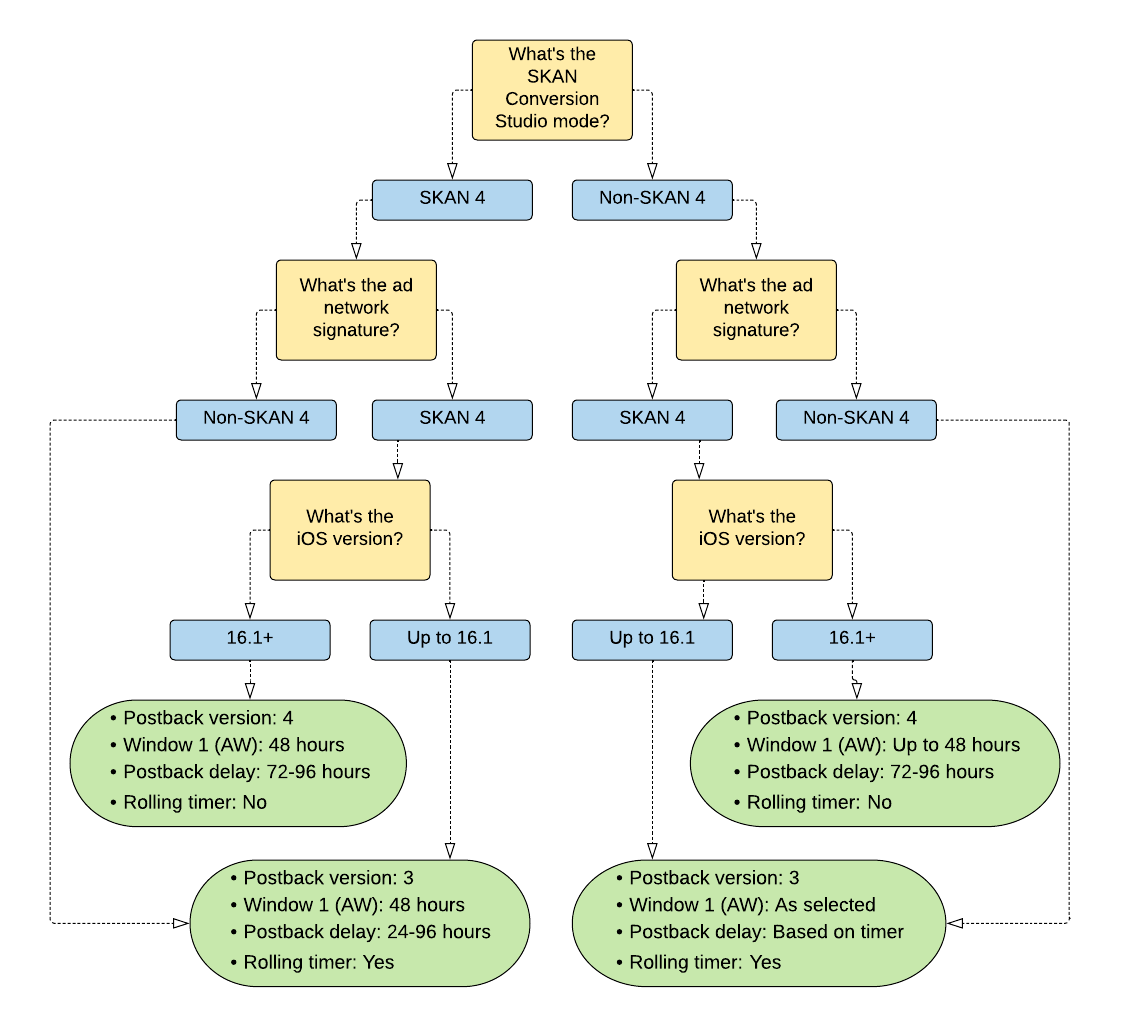
Source: Appsflyer.com
Zero Conversion Value Modeling is an advanced technique that compensates for missing data, improving the accuracy of key metrics such as eCPA and ROAS. By utilizing advanced statistical techniques, including machine learning and Bayesian statistics (used by platforms like AppsFlyer), user acquisition specialists can estimate missing values, allowing for a more comprehensive analysis of campaign results.
Different apps require varied approaches. For subscription-based apps, it’s crucial to measure events that indicate high user value (such as signing up for a trial or purchasing a subscription). In mobile games, the focus should be on revenue-related events or completing certain levels in the game (like finishing the first levels within the initial 0-2 day window).
The transition to SKAN 4.0 introduces new opportunities, such as extended measurement periods and multiple postbacks, which marketers should consider to better refine their strategies.
Finally, optimizing ATT prompts and testing different solutions can significantly impact opt-in rates, which in turn increases the availability of data for marketers.
In conclusion, despite the challenges brought by SKAN and ATT, there are also numerous opportunities for the growth of mobile marketing. The key to success is adaptation, testing new solutions, and continuously improving strategies to thrive in the new ecosystem.
9. Measuring Revenue in SKAN, e.g., in AppsFlyer (MMP platform)
In the world of mobile app marketing, measuring revenue has become quite a challenge. Let me show you how AppsFlyer (a mobile attribution platform) tackles this issue.
Two Ways to Measure Revenue
- Overall Revenue – It’s like putting all your eggs in one basket. Here, we count all the app revenues, including those from ads. Simple and effective!
- In-App Event Revenue – This is more like sorting eggs by color. We can track different revenue sources separately. This is great when we want to know which parts of our app are generating the most profit.
Revenue Buckets – How Does It Work?
Imagine you have three boxes for coins:
- Box A: From 0 cents to $5
- Box B: From $5 to $10
- Box C: From $10 to $20
Now, when someone drops a coin, SKAN doesn’t tell us exactly how much it was. Instead, it shows us which box the coin landed in and gives us the average value from that box.
Example:
- Someone spends $5 → SKAN says: “Box A” → We record: $2.5 (median)
- Someone spends $6 → SKAN says: “Box B” → We record: $7.5 (median)
- Someone spends $125 → SKAN says: “Box C” → We record: $15 (median from $10-$20)
Interesting, right? It’s kind of like a guessing game, but it gives us an overall picture without violating user privacy.
What Does This Mean for You?
- Less Accuracy, More Privacy: Yes, we lose a lot of precision.
- Creative Thinking: Now more than ever, data interpretation skills are crucial.
- Planning Matters: Well-thought-out revenue buckets can give you a better overall picture.
Measuring revenue in the SKAN era is like trying to guess how many candies are in a jar—we don’t know exactly, but we can get a good estimate. With the right approach and tools like AppsFlyer, Singular, Tenjin, Adjust, or Airbridge, you can still make smart marketing decisions.
Remember, in the world of app marketing, adaptation is the key to success. SKAN is a new challenge, but it’s also an opportunity for innovation in how we analyze data!
10. AdAttributionKit (AAK): A New Era of Ad Attribution from Apple – Hit or Miss?
In the dynamic world of mobile technology, Apple is once again meeting the expectations of marketers and developers. During this year’s WWDC conference, the Cupertino giant unveiled AdAttributionKit (AAK) – an innovative tool that could revolutionize the way we approach ad attribution in mobile apps.
What’s Behind AdAttributionKit?
AdAttributionKit (AAK) is an advanced framework that combines the best features of its predecessor, SKAdNetwork (SKAN), while introducing a series of improvements. Its main goal is to provide efficient tools for analyzing ad performance while maintaining high standards of user privacy protection.
Key Innovations of AAK:
- Openness to Platform Diversity: AdAttributionKit (AAK) opens up new opportunities for marketers by allowing better integration with various app stores. This is a step toward a more flexible ecosystem, though its full potential has yet to be revealed.
- Advanced Re-engagement Tracking: With AAK, marketers gain tools to analyze the behavior of users who already have a given app. This is a significant expansion compared to previous solutions.
- Developer-Friendly Features: AAK introduces a special developer mode, which significantly simplifies the process of testing and implementing new advertising solutions. This is a real breakthrough for teams working on app development.
While AdAttributionKit appears to be a promising tool, experts recommend cautious optimism. At this stage, marketers should continue using existing SKAN solutions while closely monitoring the development of AAK and preparing for potential transformations in the future. Whether AAK will gain importance remains to be seen.
11. SKAdNetwork 4.0: A New Chapter – What Comes Next?
The evolution of mobile app marketing on iOS in recent years has brought unprecedented challenges. The changes introduced by Apple, aimed at strengthening user privacy protection, have fundamentally transformed the mobile user acquisition landscape, presenting user acquisition specialists with a series of complex problems to solve.
At the heart of these changes is SKAdNetwork (SKAN), which has revolutionized the approach to attribution and campaign analysis. Traditional methods, relying on detailed user data, have given way to a more aggregated approach. This transformation has forced marketers to radically rethink their strategies, with an emphasis on utilizing advanced analytical and predictive techniques.
The new SKAN reality has introduced several technical complications. Extended activity windows, reaching up to 63 days (+ an additional 24-hour timer) in SKAN 3.0, provide more time for data collection but also significantly hinder quick interpretation of results. Moreover, the introduction of reporting delays has presented marketers with new challenges in real-time campaign optimization.
Predictive analytics and data modeling have become key elements of the new strategy. In an environment where direct measurement of ROI and LTV has become practically impossible, the ability to extrapolate valuable insights from limited data has become critically important.
An additional challenge is the parallel operation of different SKAN versions. While SKAN 4.0 introduces new possibilities, many ad networks are still operating on SKAN 3.0 (it’s worth reviewing data from Singular), forcing marketers to manage campaigns across two different systems simultaneously.
Mechanisms like Crowd Anonymity further complicate the situation by making data availability dependent on the scale of the campaign (based on the number of daily installs for a given campaign). This, in turn, requires marketers to adopt a flexible approach and adjust their strategies to changing conditions.
Despite these difficulties, the new era of mobile marketing on iOS also opens doors to innovation. Success in this environment requires not only technical proficiency but also a creative approach to data analysis and campaign optimization. Companies that can navigate these complex conditions while simultaneously developing advanced analytical skills have the potential to stand out from the competition.
In summary, while mobile user acquisition on iOS has become much more complex, it has also opened new pathways to innovation and a more ethical approach to mobile advertising. Companies that can adapt to the new realities, effectively leveraging limited data and developing advanced analytical capabilities, have the chance not only to survive but to thrive in this new, dynamic reality of mobile marketing.
Burger Please! – Deconstruction of an Arcade Idle Hit
What is SKAdNetwork (SKAN) and how has it revolutionized mobile attribution and user...

